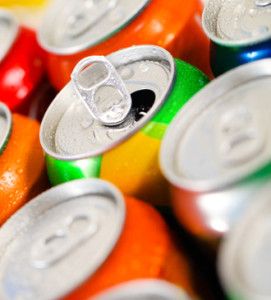 New here? Like Athlean-XX for Women on Facebook to stay up to date with new posts, great fitness and nutrition articles, motivations and inspirations, fitness challenges, Q&As, giveaways and more!
New here? Like Athlean-XX for Women on Facebook to stay up to date with new posts, great fitness and nutrition articles, motivations and inspirations, fitness challenges, Q&As, giveaways and more!
In less than a week, a new book is coming out that’s piqued the interest of a lot of folks in the fitness and nutrition industry. In Salt Sugar Fat: How the Food Giants Hooked Us, author Michael Moss exposes the truth about how processed foods are engineered to addict us, closed-doors food industry meetings, and the aggressive marketing campaigns that have created a health crisis in America and throughout the world. In fact, despite the food industry’s meeting to discuss the obesity epidemic in the late 90s, the big companies decided to continue to fatten their bottom line and give consumers more of ‘what they wanted’: salty, fatty and sugary foods.
While we tend to chalk up our own weight gain and the obesity epidemic to lack of personal ‘self-control’, the truth is that there are other important factors at play. There’s a whole industry out there working hard – with lots of research and marketing dollars – to tempt you to try their processed foods and to make you want to eat them more. While as individuals we ultimately have the power to choose what we put into our bodies, the food industry holds a large share of the responsibility for the obesity epidemic. After all, they created the foods that caused it, manipulating our taste buds and our minds in the process.
A New York Times article entitled The Extraordinary Science of Addictive Junk Food is an adaptation from Michael Moss’s book. Drawing on excerpts from the article, let’s have a look at some of the ways in which the food industry hooks us.
1) Healthy Foods Turned Unhealthy
Processed food companies don’t just invent unhealthy new foods, they also turn traditional healthy foods into unhealthy foods. Most often they accomplish this by adding sugar – lots of it. Sugar makes everything taste better and has addictive properties, leading people to eat more in each sitting and then keep coming back for more. A good example is breakfast yogurt which was at one time sold only in unsweetened varieties. By the late 1990s, General Mills had added so much sugar to its Yoplait brand that its amount of sugar per serving surpassed that of its marshmallow-filled Lucky Charms cereal. But because of yogurt’s reputation as a wholesome food, Yoplait’s revenue soared to over $500 million. Breakfast cereal is another good example of a healthy food turned sugar bomb. Before and shortly after the turn of the 20th century, breakfast cereal consisted of warm porridges and oatmeals, or cracked wheat, muesli and corn flakes. In the 1920s, food manufacturers began to refine grains and add sugars to create cereals like Kix and Wheaties which were marketed to children. Since then the amount of sugar in breakfast cereals has only increased.

Food companies begin to play with our taste buds and minds as soon as we can eat solid foods. Thousands of processed foods like breakfast cereals, are crammed full of sugar and then marketed aggressively to children, using cartoon characters, songs and prizes to appeal to them. Food companies also market children’s products to moms. In the late 1980s Oscar Mayer found its bologna sales declining due to health concerns (fat in foods was being blamed for cholesterol, clogged arteries, heart attacks and strokes). They made the move to reposition and repackage their bologna products to market to busy, overwhelmed, working supermoms who were lacking the time to prepare their kids’ lunches. Lunchables was born and brought fatty processed meats, fake cheeses, sugary drinks, crackers and candy into the lunchboxes of America’s children.
3) High-Calorie Foods as Light as Air
Ever notice how it’s possible to sit and eat an entire bag of chips, cookies or other salty junk foods? That’s because these types of foods contain such a miniscule amount of nutrients that they simply don’t make us feel full. The added sugar, fat and salt set off pleasure sensors in our brains, causing us to want to eat more. The trouble is that these fats and sugars are exactly what make processed junk foods high in calories. Pleasure plus not feeling full equals overeating and weight gain. Some junk foods like Cheetos actually have a special effect called ‘vanishing caloric density’ that makes them to be nearly impossible to put down. Because Cheetos literally melt in your mouth without you having to chew, they cause your brain to think there are no calories in them, causing you to keep on eating them until the bag is empty.
4) Engineering Pleasure
Using characteristics like ‘vanishing caloric density’ and ‘pleasing mouth feel,’ as well as adding irresistible fats, sugars and salts, food companies literally engineer foods to be perfectly addictive. It’s astonishing to learn about the breadth of engineering and consumer research that goes into junk food product development. Products go through a detailed ‘optimization’ process where dozens or maybe even hundreds of variations on a single product are consumer tested by blending different shapes, colors, flavors and packaging. Loads of data are dumped into a computer and subjected to statistical analysis to find the ‘most desirable’ combination. Says Howard Moskowitz, a food optimization specialist, “The mathematical model maps out the ingredients to the sensory perceptions these ingredients create” allowing him to literally “dial a new product.” Sensory perception maps? Sounds like we’re doomed.
As Americans began to be increasingly concerned about their health and what they put into their mouths in the early 2000s, sales for companies like Coca-Cola began to decline, even as they offered low-calorie and no-calorie alternatives to their product lines. In order to hang onto its existing market share, Coca-Cola began to aggressively market to the poorest areas in the United States including places like New Orleans where people were drinking twice the amount of soda daily as in the rest of the country. As statistics show many of the poorest populations in America are also those with the highest rates of obesity, diabetes and other diet-related health problems.
When a heavy soda drinker quits drinking soda, it takes several new soda drinkers to make up for the lost heavy drinker, so Coca-Cola found itself clamoring for new markets. To develop new markets, Coca-Cola began to push its products in some of the poorest areas in the world – places like Brazil’s favelas. In order to make their products affordable, Coke repackaged its sodas in 6.7 oz bottles and sold them for just 20 cents each. The obesity epidemic that started in America has now spread throughout the poorest countries in the world. Unfortunately, some of these countries may not have the financial resources to solve their own public health crises.
Probably none among us can say that they’ve never eaten processed food. It’s become such a mainstay of our diets and even our culture. Although food companies have begun to create ‘healthier’ processed products, many of them still contain far more calories, sugars and fats than belong in our diets. Food companies are really only interested in profits, so we must take responsibility ourselves for making the healthiest possible choices.
Trying to eat as many whole unprocessed foods as possible and making healthier choices in processed foods will go a long way in preventing your own addiction and weight gain as well as telling the food industry what we really want: healthier food! It’s important to learn to read food labels well and understand what those food label claims mean. To help with this, check out my blog series called Processed Food Health Claims. Read Part 1: What Do Whole Grain and Multigrain Really Mean? to see how even some of the ‘healthiest’ processed foods can sometimes be deceiving.
Have you personally experienced an addiction to processed foods? What did you do to combat it? What do you think food companies should do to help fight the obesity epidemic?





